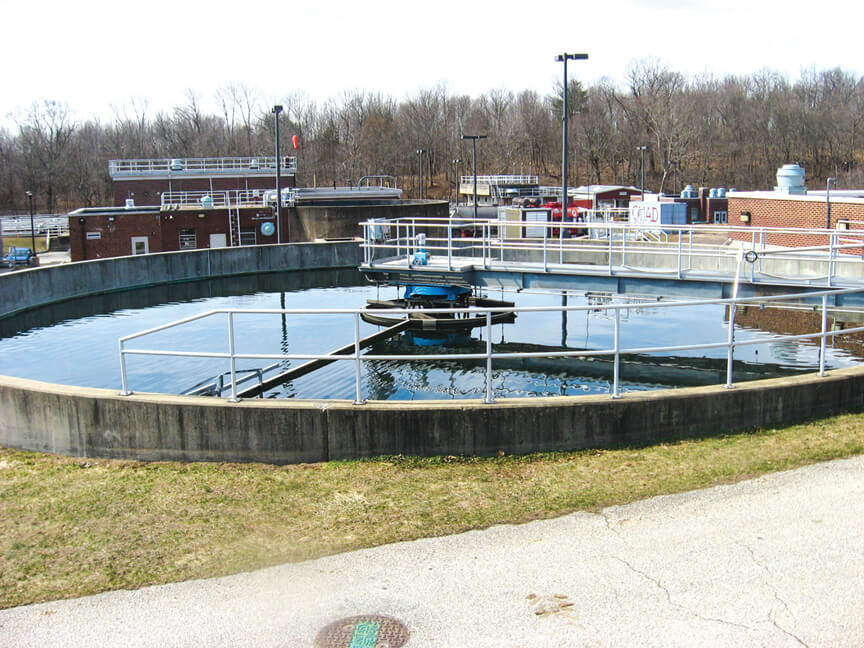Challenge
The Upper Gwynedd Township, Pennsylvania wastewater treatment plant (WWTP) which treats residential waste (70 percent) and industrial waste (30 percent) was struggling to maintain performance during peak wet weather flows. The existing facility was designed to treat an average daily flow of 5.7 million gallons per day (MGD) and a maximum monthly flow of 6.5 MGD with a peak hourly flow of 12 MGD. Water quality would deteriorate when the plant attempted to treat these peak flows, as the clarifier became the bottleneck due to lack of solids separation.
Since the facility struggled to treat its original peak design flow of 12 MGD, the plant used its available tanks to hold and equalize the flow as much as possible. The monitoring and controlling of these high-flow events was a time-consuming, operator-intensive process.
In addition, a potential future total phosphorus (TP) limit of 0.2 mg/L was another requiement to consider an upgrade to their system.
Solution
To avoid the expense of tertiary treatment and a secondary treatment system upgrade, Upper Gwynedd installed the BioMag® system with the assistance of the engineering firm, Environmental Engineering & Management Associates.
Evoqua's magnetite ballasted clarifiation process met the plant's needs without additional tankage, in-basin changes, or flow diversion during construction avoiding any treatment interruptions. The BioMag system’s fast settling rates allow it to operate with elevated concentrations of mixed liquor suspended solids (MLSS). The system also improved the quality
and stability of the Township’s effluent to the extent that the plant will be rerating to an annual average flow of 6.4 MGD, a maximum monthly flow of 7.5 MGD and a peak hourly flow of 22.5 MGD.

Unlike other high-rate clarification technologies, the BioMag® system is compatible with any type of clarifier
Results
Initial Pilot Testing
During initial pilot test of the BioMag® system, it was able to adequately treat all flow (hydraulically and organically), as well as reduce TP below the future limit of 0.2 mg/L. The pilot achieved:
- Stable, high-level treatment at elevated flows of 6+ MGD using
half of the available clarifiers, which corresponds to a peak
hourly flow of 12+ MGD - Stable, high-level treatment at organic loading comparable to 10,842 lbs. per day, which is the maximum biological oxygen demand it was designed to manag
- A lower effluent TP limit of 0.2 mg/L without adding new tankage or additional tertiary treatment steps, while maintaining consistent control over the sludge
blanket throughout a wide variety of process conditions - Total suspended solids (TSS) of less than 10 mg/L (monthly average) and less than 30 mg/L (maximum per day) during
peak flows. - Consistent nitrification and met ammonia permit levels (summer 0.74 mg/L, winter 2.2 mg/L) during design loading conditions
In the summer of 2007, a pilot of the CoMag® system proved its ability to meet the new TP limit with alum, polyaluminum chloride (PACL), ferric chloride or sodium aluminate coagulants. Additionally, the pilot proved that the CoMag® system could meet future permit limits as low as 0.05 g/L without polishing filters by simply increasing the coagulant dose.
Full-Scale Installation Results
Since it was first installed in early 2014, the BioMag® system has been successfully handling high wet weather flows and producing effluent with
TSS concentrations below 10mg/L and carbonaceous biological oxygen demand (CBOD) of less than 5 mg/L during these conditions.
Additionally, Upper Gwynedd Township completed two, seven-day performance tests in September 2014 and March 2015. The facility had to meet a 0.2 mg/L effluent phosphorous limit each time. It successfully passed with an average effluent reactive phosphorous concentration of 0.09 mg/L and 0.11 mg/L in September and March, respectively.
The Ultimate Stormwater Test
In April 2014, the BioMag® system successfully passed the ultimate stormwater test — a once-in-a-lifetime, five-inch rain event. The effluent TSS increased to 8 mg/L during the storm. Almost all of the other WWTPs in the Philadelphia area were flooded, but Upper Gwynedd’s BioMag® system easily handled the excess flow.
